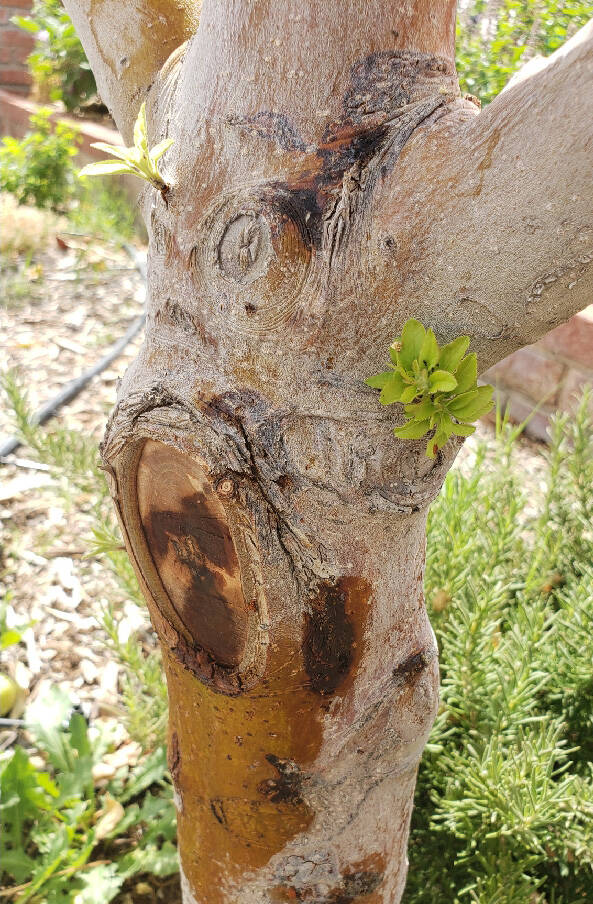Fire blight disease is highly contagious for many apple trees
Q: I came back from vacation and my Gala apple tree branch was dead. The tree also has some black spotting under the bark. I’m hoping it’s not damaged from fire blight.
A: It looks like an older fire blight disease is now in the trunk of your tree.
Fire blight is a serious disease that is highly contagious for many apples. It’s more damaging to some apples like Pink Lady than others such as your Gala. It’s particularly damaging to all Asian pears. It can be damaging to some European pears, like Bartlett, while to others, such as Keiffer, it doesn’t seem to affect.
It is damaging to some ornamentals like pyracantha and some cotoneasters in the rose family. The varieties of these plants may show differences. It just depends on the genetics of the plant combined with the genetics of the disease.
When I saw this disease in the spring, it was heavily in Asian pears, some European pears and many apples and quince. What gave it away then was the early spring growth, which was black, hooked and had the presence of sap.
What gave it away to me now are the dark cankers (black spotting) on the trunks of your trees and also the presence of sap. The sap is what is contagious and can cause it to spread. The dark cankers are probably from earlier fire blight infestations. Once this particular disease gets into the trunk, the tree usually dies.
If the tree continues to look bad or worsens, I would cut these trees down and get the pruning off of the property. You cannot use this wood for wood chips or anything near plants or it can reinfest susceptible plants.
Q: For years I’ve had a problem with weeds in certain areas of my yard. They arise in July and continue during our humid monsoon season. Every spring I give my lawn a couple of doses of Scotts Weed and Feed. I’m tired of pulling weeds by hand. It’s very tedious work, and I’m now up there in age.
A: The weed you are talking about is called spotted spurge because of the dark spots on its tiny leaves. It is a low-growing spreading weed with a milky sap when you break its spindly and thin stems. It spreads quickly into unprotected areas and germinates from its own seed that it spews everywhere from its tiny flowers.
All spotted spurge is considered a weak competitor when shaded by other plants or the soil is covered by a thick mulch, and it quickly invades areas after a rain or during frequent irrigations. In the desert, it favors the frequent irrigations of lawns, flower beds or raised vegetable beds.
Because it’s a weak competitor, spotted spurge is controlled by covering these open areas with three inches of surface mulch or shading these same areas with other plants. The existing plants must be killed first and then immediately apply a pre-emergent weed killer that attacks the seed before it germinates.
To address your situation, first kill the existing plants. This can be done with a hoe, pulling them or killing them with a chemical such as Monterey’s Spurge Power and then removing them by hand.
As soon as the existing plant is removed, immediately apply a pre-emergent weed barrier such as any chemical applied as a pre-emergent weed killer that controls crabgrass. The pre-emergent weed killers last about 30 days if left undisturbed.
Q: I purchased a Chinese pistache one year ago that was about 12 feet tall — not a small tree. Everything was fine until July, about 11 months after planting. The leaves went from deep green to dry and crunchy, quickly. The tree was watered twice a day for 25 minutes during the summer. The supplier of the tree told me it was insect damage and to water once a day for 45 minutes longer.
My concern is that all the landscaping is on the same zone. It is all doing extremely well. The landscaper has recommended 20 to 25 minutes twice per day. I’m confused because I was told that what will kill the tree is if the soil is too wet.
A: Your watering schedule is very confusing. Part of the confusion is that everything is watered the same. In landscapes, trees and shrubs should be watered separately from those plants requiring daily irrigations.
In other words, trees and shrubs are watered separately from those requiring daily waterings. Daily summer irrigation is required only for lawns, flower beds and vegetable gardens.
The frequency of irrigation (on and off) is only controlled by the irrigation valves. Irrigation valves do not control the amount of water plants receive. The amount of water they receive is controlled by the size and number of irrigation emitters.
Trees and shrubs are deeper-rooted; the amount of water they receive should only be controlled by irrigation emitters. The amount of water each plant receives depends on its size. Larger plants require more water than smaller plants.
Never plant anything living in a dry hole regardless of the time of year it’s planted. The hole should always be moist or at least mucky when planting. After planting is finished, give the soil a chance to start drying before watering again. This should be at least one day except when planting in pure sand.
If your trees and shrubs are watered the same as everything else in the landscape, it is being watered wrong. There should be at least two irrigation valves; one irrigation valve is needed for summer daily irrigations, and the second valve (or other valves) is needed for watering everything that is not watered daily in the summer. Notice I said at least two irrigation valves.
Your landscape probably needs more than two.
Next, connect an irrigation valve to those plants requiring daily summer irrigations (lawn, flower bed, vegetable garden). These are the only plants connected to this valve. Reserve the second valve for bigger plants needing nondaily irrigations.
At planting time, dig the hole for plants three times the width needed to just barely fit the plant in the hole. Not just a hole big enough to fit the plant in and call it done. This is the desert. Soils need to be amended for planting, and the planting hole needs to be wide, not necessarily deep.
Q: I received a young calamondin tree from a friend in memory of my father’s passing. I would love to nurture and grow this tree successfully. Any tips? Is it likely to bear fruit? How long should a small nursery stake remain?
A: I am sorry for your loss. In the Philippines, where it is a native, it is called calamansi in Filipino or Tagalog. So, therefore, it is subtropical, and it will not tolerate freezing temperatures, much below about 28 Fahrenheit. If we get a cold winter, it can freeze.
It does not like our desert, so it prefers locations on the north or east side of your home. Lastly, it likes amended soil so plant it either with compost mixed in the soil (one shovelful for each three of desert soil).
It grows best in soils covered in wood chips. However, if your soil is covered in rock, then rake back the rock and apply about a quarter of an inch of compost and water it in. Do this every other year.
When planting it, pound the stake into the solid ground beneath the planting hole so that it supports the tree. Then tie the tree tight to the stake with green nursery tape.
Remove the planting stake and tape after one growing season. When it gets established but still young, form a small tree by pruning it at knee height. Remove any limbs that are growing along the trunk below this cut.
The fruit is about the size of a large marble or small golf ball, and the juice and pulp are tart, like a lime. The tree should start bearing fruit when it is still small and young, perhaps the second year after it is planted. The production of fruit will become more as it gets bigger.
It is harvested when the green color of the rind starts to turn from green to light green. Filipinos use it for flavoring fish (by squeezing a cut fruit, seeds and all) and also as a beverage like a lime and many other things.
Bob Morris is a horticulture expert and professor emeritus of the University of Nevada, Las Vegas. Visit his blog at xtremehorticulture.blogspot.com. Send questions to Extremehort@aol.com.























